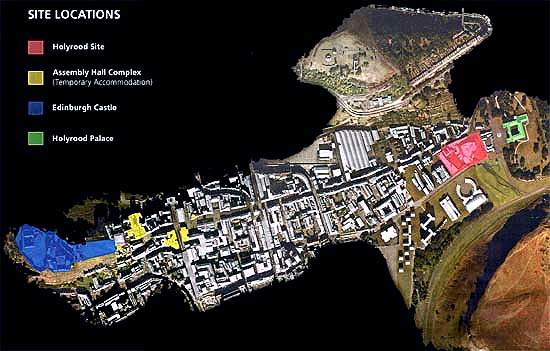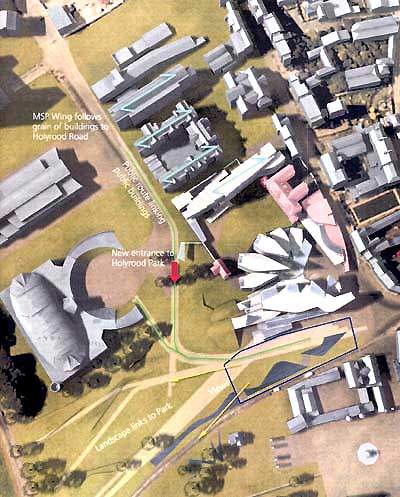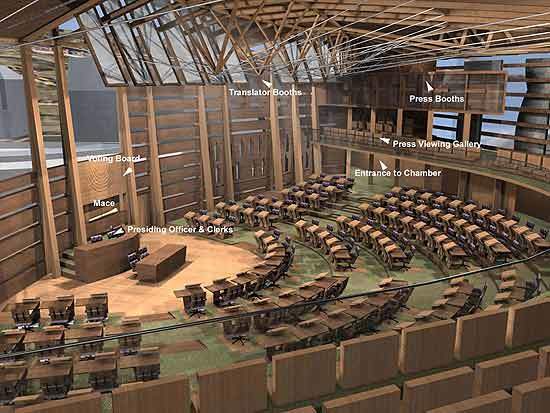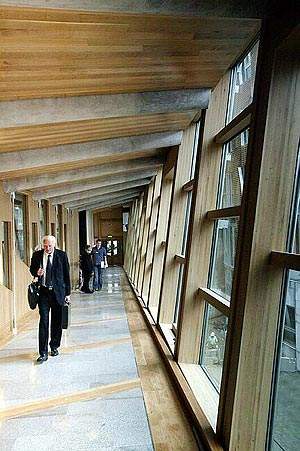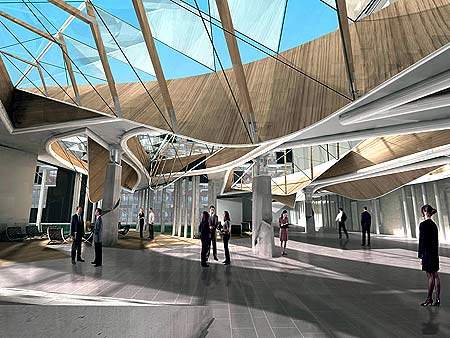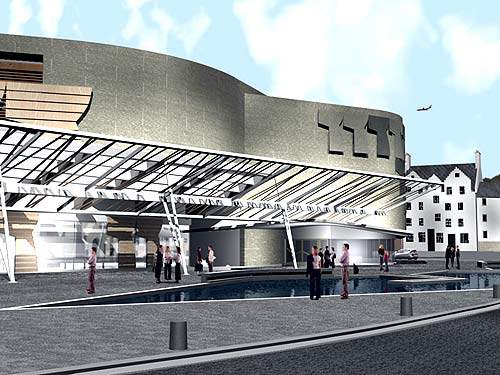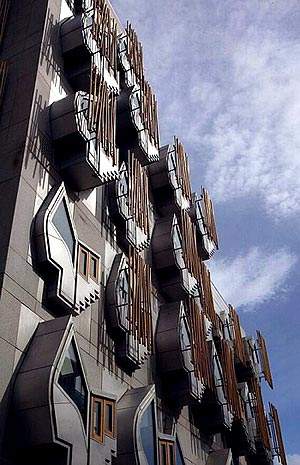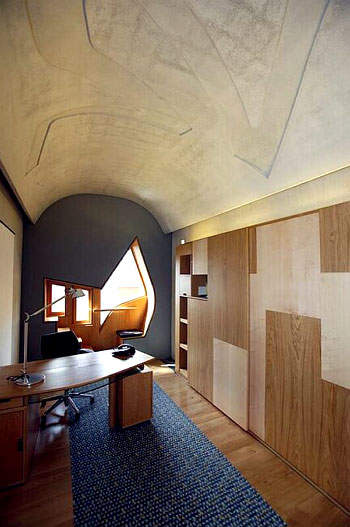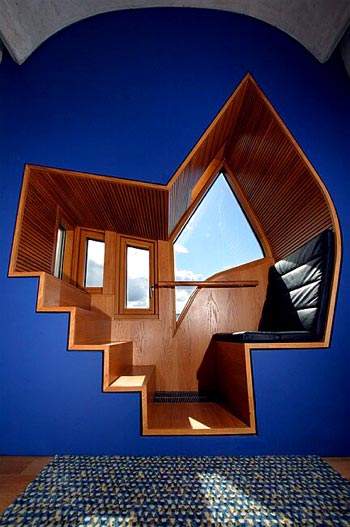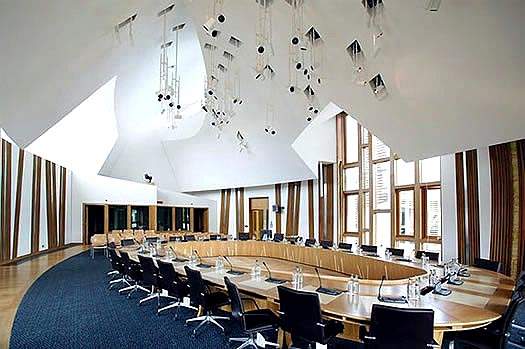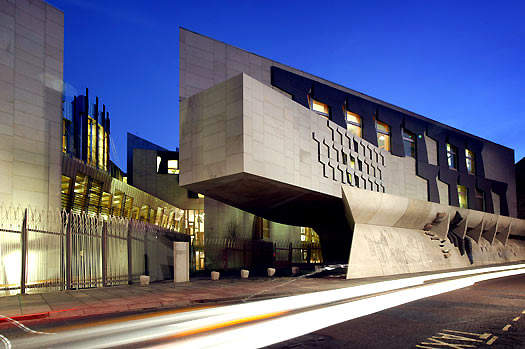A site at the foot of the historic Royal Mile was chosen for the new Parliamentary building. This followed a Referendum in 1997, when the people of Scotland voted for the creation of the first Scottish Parliament in almost 300 years, in the centre of Edinburgh. The four-acre Holyrood site is next to the Royal Palace of Holyrood House and Holyrood Park. When chosen as the new site, it was occupied by a Scottish & Newcastle brewery.
Pre-construction work (demolition of the brewery) began in April 1999, with construction starting in October 2001. The official inauguration of the new Parliament building took place on 9 October 2004, in the presence of Queen Elizabeth II, although construction completion of entire project is not planned until April 2005.
In total, the new Scottish Parliament building incorporates a debating chamber, committee rooms, facilities for the public and offices for members and staff; more specifically, the ‘campus’ includes: debating chamber, public foyer, MSP building, MSP foyer, Queensbury House, the Towers and Canongate buildings.
FUNDING
This is a very contentious issue. In 1997, in the early days of planning, a figure of £40 million of government money was set aside for the project. This amount remained static until June 1999, when the responsibility for the project was handed over to the Scottish Parliamentary Corporate Body – and the building cost increased to £109 million. The increase was due to additional construction, over and above the initial plans, in order to provide more circulation space and additional space
for staff, as well as creating a new formal entrance.
In April 2000 the cost rose again – this time to £195 million – as it became important to incorporate even more space for staff and MSPs (Member of the Scottish Parliament). Inflation increased this figure marginally again to £197 million in June 2001.
Towards the end of construction (final quarter of 2004) the estimated total cost of the Holyrood building project was £431 million – 11 times more than first planned. Public outcry resulted in the ‘Holyrood Inquiry’ to be carried out by Lord Peter Fraser of Carmyllie QC. This inquiry, to look at the reasons behind the escalating project cost, is still ongoing.
CONTRACTORS
After a tough competition, in July 1998, the Spanish architectural practice led by Enric Miralles, in partnership with Edinburgh-based RMJM (Scotland) Limited, was chosen to design the new Parliament building. This was followed in January 1999 by the appointment of Bovis Lend Lease as Construction Managers for the project.
The architect Enric Miralles died in July 2000; his widow, Benedetta Tagliabue, took over as one of the lead architects. Ove Arup was the structural, civil, geotechnical and facade engineer; RMJM (Scotland) Limited was the service engineer; and Davis Langdon & Everest was appointed as the quantity surveyor and cost consultant for the project.
Non-design appointments include Turner & Townsend as planning supervisor, Cairn Property Services as building standards regulations consultant, and Buro Happold as access audit consultant. Lanarkshire-based IT services company, Stiell Networks, won a £560,000 contract to provide the new Scottish Parliament building with a state-of-the-art communication infrastructure.
Building materials from the Highlands of Scotland were supplied by Caithness Stone Industries Ltd of Wick, and Cromartie Timber Ltd of Strathpeffer, near Dingwall. Caithness Stone Industries supplied around 500m² of Caithness flagstone, worth approximately £250,000. Cromartie Timber was one of 13 Scotland-based timber suppliers that supplied Scottish oak to the building.
In 2001, Edinburgh-based Art in Partnership were appointed as consultants for the implementation of an art strategy for the new Parliamentary building.
OVERALL DESIGN
The architect’s concept for the design was an “intellectual vision was for a unique institution – open, anti-classical and non-hierarchical. The architecture that expressed this was to be de-institutionalised, aggregated, and organic – embracing the landscape and defying all the canonical rules of architectural composition.”
The most prominent idea in the design was that “the Parliament sits in the land”. This means that, although the buildings are located in Edinburgh, they belong to a greater entity. This is symbolised by the landscape sweeping in from the flanks of Salisbury Crags up to and under the raised forms of the superstructure.
DEBATING CHAMBER
The ground floor of the debating chamber is the main public space with reception, restaurant, education centre, shop and exhibition areas. From here you can access the public gallery of the chamber and the six committee rooms in the adjoining tower buildings.
The frame of the chamber building is predominantly steel, clad in high quality pre-cast concrete panels. The ceiling on the ground floor consists of three concrete vaults. Each vault was cast on-site and features Enric Miralles’ abstract designs of the Saltire cross. A light well in each of the three vaults allows natural light to penetrate the space. In addition to natural light provided through perimeter glazing, artificial light is provided from spaces between the vaults and feature lighting
suspended from some of the Saltires. The flooring is a mixture of Kemnay granite, Caithness stone and oak.
The floor of most of the chamber is covered in carpet designed by Enric Miralles. The well of the chamber (the space in front of the presiding officer’s desk) will be Scottish Oak.
The unique roof structure of European laminated oak beams and stainless steel nodes (connecting joints) is clearly visible.
MSP BUILDING
This building provides office accommodation for 105 MSPs. Each MSP has an office of 15m² with space immediately outside the office for up to two members of staff. The basement contains a 65-space car park.
The north side of the building is six storeys high, decreasing to four storeys on the south side, which overlooks Holyrood Park. It is constructed with a mixture of pre-cast and on-site cast concrete units. The vaulted ceilings, a feature of this building that weigh 18t each, were cast off site and lifted into place. Externally, the building was clad in a mosaic of materials, which includes Aberdeenshire Kemnay granite.
MSP FOYER
The MSP foyer space is the social centre of the complex, linking all the areas of the building.
The foyer roof consists of a curved roof plane into which are located 13 leaf-shaped roof lights of differing sizes and orientations, allowing natural light to flood the space.
QUEENSBURY HOUSE
Queensbury House is a 17th century “A” listed building. It contains the offices of the presiding officer, the two deputy presiding officers, the clerk/chief executive and their staff as well as other support staff. The Donald Dewar Reading Room, named after the late First Minister Donald Dewar, is located here also.
After removing the 19th century plaster throughout the building, under archaeological supervision, it was discovered that the building was in a poor structural state. The top storey, added in 1808 when the building was used as army barracks, was removed and replaced by a pantiled roof of a steeper pitch. The external walls were re-harled and lime-washed.
Internally, the original timber flooring was removed and replaced with steel beams and concrete floors. Walls were strengthened and secondary glazing added to meet security requirements. Where stonework is of a high quality it has been left exposed. The remaining walls are covered in plasterboard and painted.
A mixture of floor coverings have been used in the building including carpet, oak, vinyl and Caithness stone.
THE TOWERS
Four towers wrap round the rear of the debating chamber building. Six committee rooms are located in the tower buildings along with constituency meeting rooms. The towers are made from reinforced concrete that was cast on-site. The upturned boat-shaped roofs are covered in tern coated stainless steel. Each committee room has a complex vaulted ceiling. The walls are covered with acoustic panels and plasterboard with oak insets. On the floor, there is oak round the edge of the rooms, with
carpet in the centre.
A fifth tower, the media tower, is attached to the debating chamber.
CANONGATE BUILDINGS
There are two Canongate buildings: one is a new building constructed behind the original facade of 58-60 Canongate; the second is totally new and has a cantilever design. The finance and procurement offices occupy the first building, the IT staff and the Scottish Parliament Information Centre (SPICe) occupy the latter.
Behind the existing façade a new structure was constructed of steel and concrete. The cantilever of the new building is supported at one end by a reinforced concrete structure; the building spans approximately 18m without any supporting columns.
The floor covering in the office areas is a mixture of oak and carpet. The stairs and landings are covered with Caithness stone.
PUBLIC FOYER
The public foyer is situated directly below the debating chamber. Abstractions of the Saltire are interspersed by incisions on the surface of the concrete vaults. The geometry is broken by deep light wells carved into the vaults below the chamber seating, which bring shafts of light into the space.
LANDSCAPE
The architect’s “sitting in the land” vision was also carried into the landscaping surrounding the site. Scottish wildflowers, trees, shrubs and water and lighting features are included, as well as gabion walls constructed from stones of some of the buildings previously on the site. The area, with its walkways and cycle routes, is an open and accessible public space, which also contains a public gathering space.

